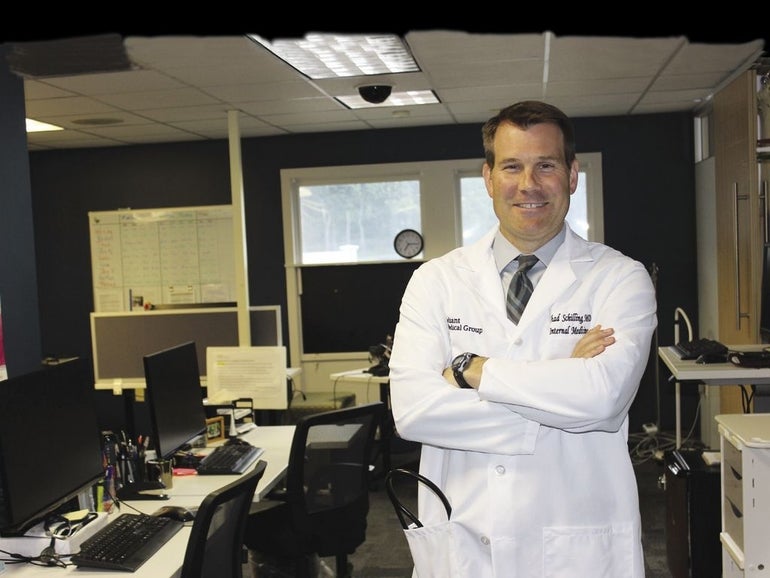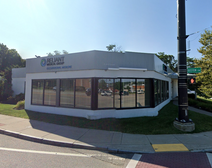Healthcare providers maximize resources through teams
 Laura Finaldi
Dr. Thad Schilling, chief of primary care and car transformation at Reliant Medical Group, is one of the doctors who works in the model cell.
Laura Finaldi
Dr. Thad Schilling, chief of primary care and car transformation at Reliant Medical Group, is one of the doctors who works in the model cell.
In a small subsection of Reliant Medical Group’s offices on Plantation Street in Worcester, there is a workspace that doesn’t really look anything like a traditional doctor’s office.
Instead of doctors being confined to their offices and nurses to their stations, this room is wide open. Doctors sit at desks next to nurse practitioners, who sit across from nurses, who sit next to medical assistants. Almost everyone can see each other working, and the whole office area directly adjoins four patient rooms, each blocked off by both a door and a curtain.
It’s not a fancy looking space, but it is the blueprint on which Reliant is going to base its future primary care strategy. The open work environment, which the company is calling its model cell, is a live primary care practice that is also an experiment to find out what works and what doesn’t for patients and staff as the company looks to lease new primary care offices over the next four years.
The model cell is Reliant’s physical manifestation of a team-based primary care approach to primary care. This approach is something healthcare providers across Central Massachusetts have been integrating into their practices for years. As the country prepares for a looming shortage of primary care physicians and an increase in the number of patients with health insurance as a result of the Affordable Care Act, many providers see the team-based approach as a more effective use of their resources.
“As you put people together in a shared space, they do a lot of problem solving on their own,” said Dr. Thad Schilling, chief of primary care and care transformation at Reliant. “You start working collaboratively in a very positive way.”
Top of their license
A team-based approach to primary care isn’t a new concept, said Dr. David Polakoff, chief medical officer and associate dean of UMass Medical School’s Commonwealth Medicine Division. It was central to some early managed care models, and has been a part of primary care, pediatrics and geriatrics for a long time.
In the long run, the idea is a team-based approach will lead to a reduction in costs for providers and then eventually, patients, because each specialist is making the best use of his or her training. That’s especially important as the medical profession faces a shortage of 12,500 to 31,000 primary care physicians by 2025, according to the Association of American Medical Colleges.
“There’s a phrase in medicine, which is, ‘Keep every member of the team working at the top of their license,’ so you don’t have physicians doing what nurses should do, you don’t have nurses doing what educators should do, and you don’t have educators doing what a care coordinator should do,” he said.
At Reliant, the basic four-person team in the model cell includes a nurse, doctor, medical assistant and nurse practitioner.
This has been good for the staff because they feel like their time and energy are being used effectively, Schilling said.
At UMass Memorial Health Care’s primary care offices, practices are becoming more streamlined, said Dr. Daniel Lasser, chair of the department of family medicine and community health and senior vice president for primary care.
Eight of UMass Memorial’s largest primary care offices are designated as patient-centered medical homes by the National Committee for Quality Assurance, Lasser said, which means they use a team-based approach, are available after hours, coordinate care with emergency rooms and do pre-visit planning.
Future primary care doctors looking into residencies with UMass often look for this criteria, Lasser said.
“They want to learn in these kinds of settings. The fact that we have done this in a larger teaching practice is good for teaching the next generation of providers [and] makes us attractive to people applying for residency programs or even for medical students,” he said.
Value-added approach
One of the obstacles to fully transitioning over to a team-based model is the still widely used fee-for-service reimbursement model, which focuses almost entirely on frequency of doctor-to-patient interaction. With the ongoing shift towards a team-based approach comes a need for different forms of healthcare reimbursement.
Polakoff co-leads the Southern New England Practice Transformation Network, a federally-funded joint initiative between UMass Medical and the University of Connecticut School of Medicine geared towards helping Medicare and Medicaid transition more fully towards an alternative model.
“More visits doesn’t necessarily mean patients are healthier,” Polakoff said. “We are trying to transition into a model where practices are paid to keep people healthy.”
The current fee-for-service standard has contributed to a slower rollout of team-based primary care at Harrington HealthCare System in Southbridge, which started integrating teams into its primary care model back in 2009, said Kristin Morales-Lemieux, Harrington Physician Services vice president and chief operating officer.
“Like with anything else, I think the funding has been a little bit slow to the ideas,” she said. “What it means is that we’ve transitioned slower than we would have otherwise.”
UMass Memorial’s primary care offices are in various stages of converting to a team-based model, but Lasser said he expects that process to speed up as more insurers adopt different models.
Modular environment
Reliant’s model cell includes four patient rooms that directly adjoin the open work space where two teams of doctors, registered nurses, nurse practitioners and medical assistants sit.
Everything in the office and the patient rooms themselves is on wheels, so the staff can experiment with the best use of their space. Each patient that comes through is also given the option of providing real-time feedback through an iPad survey on their experience being treated in the model cell at the end of their visit. That feedback will factor into Reliant’s future primary care structures.
The open work environment, flexibility of structure and close proximity to one another has created a collaborative sense among the people who work in the model cell, Schilling said. That’s a very valuable thing, especially because burnout rates among primary care workers are very high.
“[The staff] actually gets to control things about the environment. That’s been empowering for them,” Schilling said. “We know we will be successful in helping our patients if employees are engaged and inspired.”
A second model cell, opening in July, will be twice the size of the first one. It will integrate a behavioral health specialist, which is important because behavioral health problems tend to manifest themselves as medical problems, Schilling said.
Harrington has full-time behavioral health specialists in its Charlton and Webster primary care offices, due to a $3.5-million grant from the Massachusetts Health Policy commission.
A lot of times, a patient would come in for a medical problem and then begin to open up about a behavioral health or substance abuse issue, Morales-Lemieux said. In the past, that patient would have to go home and set up an appointment with a specialist, but most patients didn’t follow up afterwards, she said.
“When we went to chase them down after the fact, they were no longer interested in talking to anybody,” she said. “That’s why it’s important to have someone located right in the suite, have a visit with the person, make a connection, make an appointment with the appropriate party and get them on their way.”













0 Comments